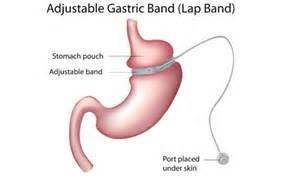Adjustable Gastric Banding is a surgical technique where a silastic ring is placed around upper part of the stomach. The ring has an inner balloon, which can be regulated by injecting, or removing saline via access to a subcutaneous port implanted underneath the skin. The port is connected to the ring by a tube.
Initial success of the gastric band was demonstrated in Europe and Australia before it was brought to U.S. in 2000. In 2000, FDA study showed the adjustable ring to be safe and it was approved for use in U.S.
There are two major brands of gastric band in U.S.: Realize Band and Lap Band. The O Band is a different name for the Lap Band.
Although the idea behind the gastric band was that it was safer than other bariatric procedures, time has proven this not to be correct.
The major complications with the adjustable band are slippage and erosion. Both of these complications can be life threatening and require surgical intervention. The rates of complications have been as high as 80% in some studies.
Given that the success of long-term weight loss of more than 50% of excess weight loss has shown to be 25% or less, the benefits of the procedure does not outweigh the risk associated with it.
Recently, it has been more common to remove the band and convert to different procedures. In fact, even in Europe, Asia and Australia, the gastric band placement is rapidly decreasing.
At Suh Bariatric Center, existing gastric band is managed but placement of new band is not recommended.


